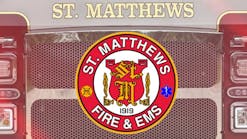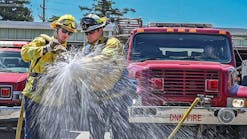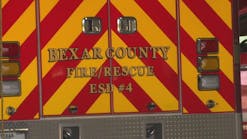Use the information below to answer questions 1, 2 and 3:
At 3:00 a.m., firefighters at House Number 9 were dispatched to respond to a fire involving two adjacent two-family homes numbered 136 A, 136 B, 137 A, and 137 B. When the firefighters arrived on the scene, both two-family homes were fully involved and some residents were standing outside. One of the residents, Mrs. Renner, came running up to Captain Keller, the commanding officer on the scene, to inform him about the status of the other residents. Mrs. Renner indicated that the occupants of 136 A, Mr. and Mrs. Spina and their daughter Helen, were on vacation. She was especially sure of this because the Spina's car was still gone. Mrs. Renner added that she, her husband and her son, Gary, had gotten out safely from 136 B. Mrs. Renner's son, Gary, informed the captain that he had gone around back to see if Mr. and Mrs. Simms, the elderly couple who lives alone in 137 A, had escaped through the back. Gary indicated that he could not see anyone and Mrs. Renner added that she hadn't seen the old couple either and was hoping they had already left town for their annual summer vacation. Finally, Mrs. Renner pointed to her neighbors from 137 B, Mr. and Mrs. Sloan, and indicated that they had gotten out safely and that they had no children in their home.
1. The following number of individuals normally reside in the homes on fire:
A)8
B)9
C)10
D)11
2. The address of the home that may still be occupied is:
A)136 A
B)136 B
C)137 A
D)137 B
3. The person who had gone around back to check for the elderly couple was:
A)Mrs. Spina's daughter
B)Mrs. Renner's son
C)Mrs. Renner's husband
D)Mr. Sloan
Use the information below to answer questions 4-6:
Hoselines
At the scene of a fire, crews attempting to perform a rescue should have every kind of protection available. The primary type of protective equipment is a hoseline with an adequate supply of water. The advantages of a fire stream are its effect in the control of fire in the rescue area and its cooling effect. The force of a water spray will also help ventilate the structure. This will help to provide cool fresh air, which will assist the victims as well as the rescue crew.
Another advantage of taking in a hoseline is that the hose automatically marks an escape route. If the conditions in the structure worsen, smoke may decrease most visibility. When this occurs, the hoseline will lead the rescue team out of the structure. Since searches for victims in the fire structure must be done quickly, the rescue crew may not be able to use hoselines in all cases. However, as the rescue continues, hoselines should be advanced to protect rescue workers and trapped victims. Fire streams may have to be used to knock down the fire and to protect victims.
At times it may be necessary to delay rescue in an area until a charged hoseline is ready to advance. The rescue crew must then enter the structure behind the protection of the fire stream. As the fire is controlled, the rescue crew can search each room.
To speed up the search of the more distant rooms, the rescue crew can leave the protection of the charged hoseline. Before this occurs, the rescue crew must tell the firefighter on the charged line of their actions.
Firefighters on the fire floor must keep in mind the presence of other rescue crews on the floors above the fire. If it appears that the fire streams will be unable to hold the fire, instant warning must be given to the crews above the fire. Steps should be taken to provide escape by ladder. An effort should also be made to place fire streams between the fire and the exposed rescue crews.
Caution must be exercised when stretching hoselines to keep them from blocking any rescue attempts. The one exception to this would be where the fire stream is required to protect the occupants' escape. When many persons have to get out of a building, rescue plans must be considered in the placement of equipment. This includes the stretching of hoselines.
While hoselines are designed as an extinguishment device, it is clear they are very effective in the rescue process. Firefighters must use the hoselines to assist them in all rescue operations for their safety and the safety of the trapped victims.
4. Firefighters must exercise extreme caution when stretching hoselines to keep them from blocking any rescue attempts. The one exception to this would be:
A)when a fire stream is used to cover a nearby exposure
B)the fire floor is fully engulfed in flames
C)when a fire stream is required to protect occupants' escape
D)when salvage operations have begun
5. You are on Engine 17 and have taken a hoseline into the second story of a three-story building. Engine 22 has proceeded to the third floor and is attacking the fire that is spreading upward. While fighting the fire on the second floor, you realize that extinguishment operations are going to be difficult if not impossible and it appears that the fire is stretching above to the third floor. Which of the following would be the correct procedure?
A)order additional help into the second floor area to alleviate the situation
B)give a warning to the members of Engine 22 above you that the fire has spread into the third floor area
C)withdraw your crew members immediately and escape by ladder
D)limit the amount of rescue and ventilation operations
6. According to the passage:
A)Crews attempting to perform rescue should have every type of protection available. The primary type of protective equipment is an operating air mask.
B)During rescue operations, firefighters for their own safety and that of trapped victims can call on the assistance of hoselines to provide them with direction.
C)An uncharged hoseline with a water spray will help ventilate a structure allowing for additional assistance in rescuing the victims.
D)decrease the amount of hoseline stretched into the area while increasing horizontal ventilation
Use the information below to answer questions 7-10:
In investigating an explosion it must first be determined whether a diffuse or a concentrated explosion has occurred. Diffuse explosions occur as a result of the ignition of natural gas, vapor from volatile liquids, or dust in an enclosed area. Thus, many diffuse explosions occur accidentally. In most cases, a diffuse explosion will create no crater or discoloration. It may or may not be followed by a fire, depending on the conditions at the time of ignition. In a diffuse explosion, the nature of the exploding material may often be determined by examination of the structure. If the explosion was caused by vapors which are lighter than air, such as natural gas, the explosion will tend to push out the walls of the structure near the top causing the ceiling to collapse. An explosion of vapors which are heavier than air, such as gasoline or kerosene, will tend to push out the walls near the bottom.
In a concentrated explosion there is a secondary force following the explosion, known as return force, or implosion. Frequently the explosion merely weakens the structure and the implosion causes it to collapse. High order concentrated explosions result from dynamite, TNT, and similar materials. This type of explosion is distinguished by local shattering and the presence of a crater. When craters are found, all crater materials should be collected, sealed and forwarded to the laboratory for examination. In low order concentrated explosions from such materials as black powder, an investigator should be able to find some unburned explosive that was blown outward from the center of the blast. Fragments of the container or the ignition device may also be found embedded in objects along the leading edge of the explosive force. In investigating all explosions, it is important to provide a careful sketch and photographs of the entire area; and to preserve all evidence from deterioration, change or modification.
7. Which of the following explosions is most likely to be accidental?
A)an explosion where the base of the walls of a structure is blown outward
B)an explosion in which there is considerable shattering of objects
C)when there is considerable structural evidence of implosion effects
D)when a crater area of special damage is found
8. An explosion in a small warehouse resulted in the ceiling's collapsing. If no crater is observed, which of the following would be the most probably cause of the explosion?
A)arson caused by gasoline spread evenly on walls and floor
B)a leak in the gas main to the heating system
C)a homemade bomb constructed of lead pipe and black powder
D)several sticks of dynamite or plastic explosive placed in the center of the room
E)spontaneous combustion from kerosene soaked rags in a metal container
9. After an explosion in the living room of a residential home, a couch and the floor beneath it are found to be severely damaged. While the windows are blown out and one of the walls slightly caved in, most of the furniture in the room is only moderately damaged. These circumstances suggest that the damage was caused by:
A)a high order concentrated explosion from some material such as dynamite
B)a diffuse explosion resulting from the ignition of a volatile liquid
C)a low order concentrated explosion, probably from a homemade bomb
D)a gas leak in the basement
E)gasoline on the couch
10. Which one of the following statements is implied by the passage?
A)diffuse explosions are less likely to result in a fire than concentrated explosions
B)the results of an implosion are more likely to be visible on the structure than the primary force of a concentrated explosion
C)crater material is likely to be the most valuable evidence in a low order concentrated explosion
D)explosions involving high degrees of local shattering are not likely to produce much evidence concerning the explosive device used
- C - 10
- C - 137A
- B - Mrs. Renner's son
- C - When a fire stream is required to protect occupants' escape.
- B - Give a warning to the members of Engine 22 above you that the fire has spread into the third floor area.
- B - During rescue operations, firefighters for their own safety and that of trapped victims can call on the assistance of hoselines to provide them with direction.
- A - An explosion where the base of the walls of a structure is blown outward.
- B - A leak in the gas main to the heating system.
- A - A high order concentrated explosion from some material such as dynamite.
- B - The results of an implosion are more likely to be visible on the structure than the primary force of a concentrated explosion.
Additional practice exams can be found here. Good luck !!
Since 1950, Don McNea Fire School has prepared over 40,000 fire applicants with our entry level seminars and products. Fireprep.com has over 250 pages of FREE information and career articles to help you reach your goal of becoming a firefighter.Go to www.fireprep.com and register for our free fireprep e-mail newsletter that currently has over 20,000 subscribers.
If you want to start getting that competitive edge immediately over your competition, our 14 day FREE e-mail series covers the written, psychological, oral interview and physical agility. This e-mail series will guide you step by step through the maze of the testing process to help you shorten that learning curve between you and that coveted badge. As soon as you sign-up you will receive the first e-mail with important inside secrets. You have nothing to lose and everything to gain!! Go to the link below for our 14 day e-mail series sign-up. Good luck !! Click here: Fireprep.com Free 14 Day Email Series
Click here: Free 50 Question Firefighter Practice Examination, Free Firefighter Exam Questions 1-10
Information on 'How to become a firefighter'
Don McNea Fire School www.fireprep.com
Click here to send an email
1-800-989-FIRE





